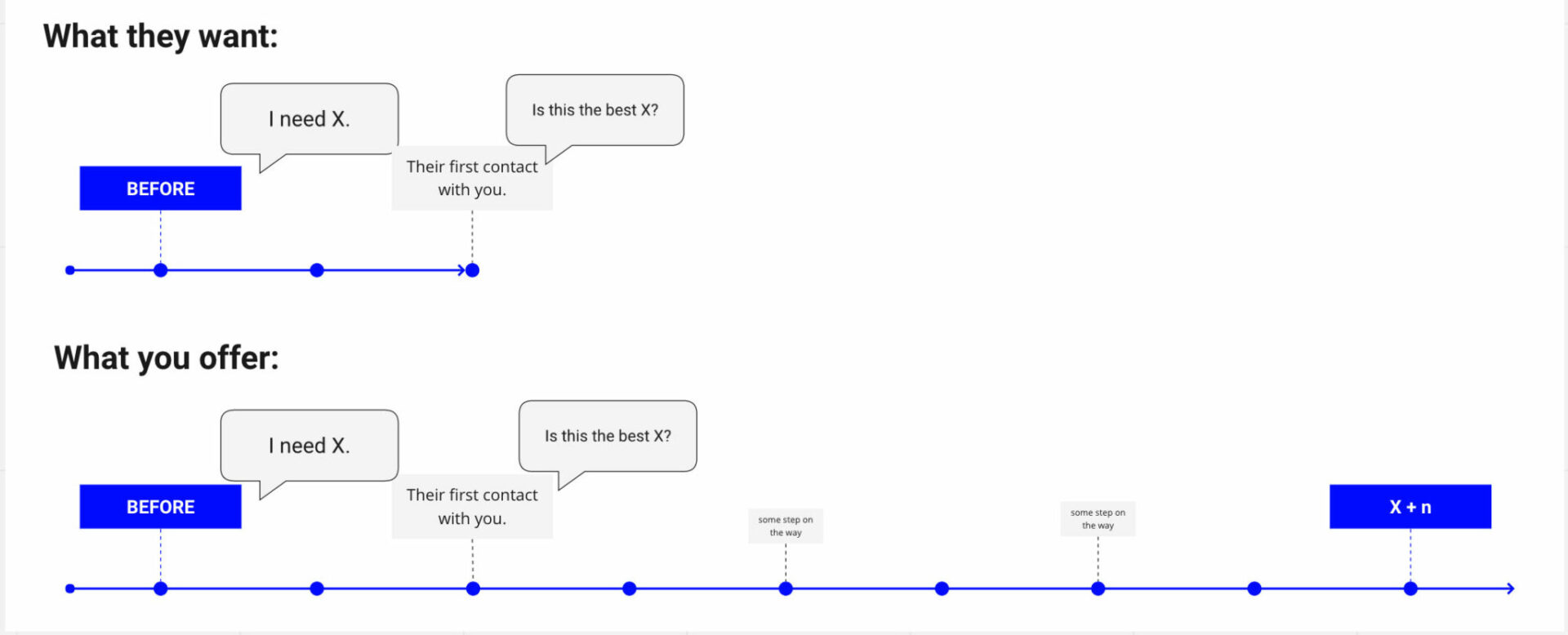From First Hello to Fond Farewell
In Step 1, we talked about understanding your personas and planning how to take them from BEFORE to AFTER. Now it’s time to map out exactly how that journey happens.
Think of it this way: Your subscribers enter your sphere of influence at point A. They need to get to point Z. What happens in between… well, that’s where most email marketing programs go wrong.
Two Very Different Paths
Let me tell you about two fundamentally different types of products, because understanding this difference will change everything about how you approach email marketing.
Step 2: Understanding The Flow
From First Hello to Fond Farewell
In Step 1, we talked about understanding your personas and planning how to take them from BEFORE to AFTER. Now it’s time to map out exactly how that journey happens.
Think of it this way: Your subscribers enter your sphere of influence at point A. They need to get to point Z. What happens in between… well, that’s where most email marketing programs go wrong.
Two Very Different Paths
Let me tell you about two fundamentally different types of products, because understanding this difference will change everything about how you approach email marketing.
The Commodity Path
Let’s talk about lemons.
Yes, lemons. Stay with me here.
When someone wants to buy a lemon, they know exactly what they’re looking for. They know what it looks like, what it costs, and how they’ll use it. They don’t need you to explain the “transformative power of citrus” or the “hidden meaning of yellow fruit in their life.”
They just want to buy a lemon.

If you’re selling a commodity, your entire business revolves around serving these clear expectations as efficiently as possible. No fluff, no “amazing deals,” no “did you know” facts about lemons. Just help them get what they want, maybe suggest a lime or some sugar if it makes sense, and you’re done.
That’s probably how most businesses operate. And there’s nothing wrong with that.
The Journey Path
But what if you’re not selling lemons?
What if you’re selling something that requires your customers to change their behavior, learn new skills, or transform some aspect of their life?
Now we’re talking about a journey. And journeys are different. Your customers might not even fully understand their problem yet, let alone know the solution.
This is where most email marketing programs get confused. They treat transformational products like commodities, or worse, treat commodities like they need a transformational journey.
Here’s the thing about journeys: Your customers are essentially being asked to step off a cliff into darkness.

But here’s the beautiful part – while it’s darkness to them, you can see the entire path. You know exactly what steps they need to take. You know what decisions they’ll face. You know where they might get stuck and where they’ll need encouragement.
It’s like you’re writing their story. (Just don’t go all Stephen King on them!)
That’s why you need to frame their position at each step so they can build the belief that the next step is the most logical one to take. They need to believe in and agree with what you’re saying at every step of the way.
Building the Journey
You should actually design these steps in reverse chronological order:
- Start with point Z (they’ve reached their AFTER state)
- Then point Y
- Then point X
- And so on
At each step, ask yourself: What do they need to believe and agree to before they can move forward?
As Jay Abraham says, you need to be their most trusted advisor in your particular area. This isn’t just good salesmanship – it’s about pulling your prospects toward their destination rather than pushing them from behind.
The Three Critical Stages
“Enough theory,” you might be thinking. “Let’s talk about actual email marketing!”
Fair enough. Let’s break this down into the three stages that make or break any email program:
Stage 1: The Opt-in (Where Most Things Go Wrong)
Let me tell you a story that plays out in companies every day…
You’re running a SaaS company. You’ve got a beautiful registration form asking for email addresses. Users sign up, and you immediately let them into your application while a confirmation email wings its way to their inbox.
You’ve spent huge resources making your onboarding amazing. Your product team has crafted the perfect first-time user experience.
“So far so good,” you think.
But being the data-driven marketer you are, you check your stats. Only about 50% of registered users have confirmed their email addresses.
“No problem,” you think. “We’ll just add a confirmation reminder! They must have forgotten to check their emails because they were busy with our awesome app.”
The numbers don’t budge much. You dig deeper:
- Open rate is around 40%
- Click-to-open rate is 80%
“Must be going to spam,” you conclude.
Wrong, grasshopper.
If your emails were really being filtered to spam, you wouldn’t see a 40% open rate. That’s actually a pretty good open rate! Combined with an 80% engagement rate from those who open, ISPs definitely don’t think you’re spam.
So what’s really happening?
If you had an advanced inbox monitoring tool like Everest (ex ReturnPath and 250OK), you’d probably see something interesting: lots of missing and unknown users on your transactional IP address.
(You have separated your transactional and marketing IPs, right? And you’re using dedicated IPs? You’re not? Oh boy…)
Your real problem: fake email addresses in your registration form.
The Two Types of Fake Emails
This gets interesting. There are two kinds of fake emails you need to worry about:
- Fake local-parts (the thing before the @) These bounce because they don’t exist on the ISP (Google, Yahoo, Microsoft, etc.). They hurt your sending reputation through high bounce rates.
- Fake domains These are sneakier. They don’t bounce, and sometimes they’re actually spam traps (like gmai.com) that silently report you to Spamhaus, SpamCop, and others.
And here’s something that’s not conspiracy theory: competitors can purposely infect your list with pristine spam traps. Yes, this actually happens.
Protection Strategies
If you’re using MailChimp or similar self-cleansing ESPs, they handle this for you. How do you know if your ESP self-cleanses? Look for these signs:
- Newly added, unconfirmed emails don’t appear on your list
- They don’t give you a dedicated IP by default
- They have a low hard bounce and abuse threshold
But if you’re using an ESP that gives you control (and responsibility) over your IPs, or if you’re running your own infrastructure, you need three layers of protection:
First Layer: Syntax Checking
A simple JavaScript that checks email syntax in your forms. When someone types “[email protected]“, it suggests “Did you mean gmail.com?”
Important: Never auto-correct email addresses. Never. Just don’t.
Second Layer: List Hygiene Service
These services maintain databases of known spam traps and provide APIs for bulk list cleaning. Not 100% accurate, but cheap and catches obvious problems.
Third Layer: Email Validation Service
These services actually verify email addresses exist through SMTP ping (similar to sending an email). Never try this yourself – you’ll get blocked by ISPs faster than you can say “deliverability problems.”
I recommend Kickbox.com. Been using them since 2016, great service, fast API. There are others like NeverBounce, Emailable (ex Blaze Verify), Zerobounce, but I stick with what works.
Stage 2: The Single vs Double Opt-in Debate
This debate has been raging for two decades now. Let me break it down simply:
Double opt-in means users must click a confirmation link after subscribing. Single opt-in just adds them to the list immediately.
Double opt-in is safer. Single converts better. Double increases lifetime value because users invest more energy. Single provides better user experience.
Here’s how to choose:
If you have a slow funnel with many steps before conversion, use double opt-in. One extra step won’t hurt.
If you need quick conversion:
- Small margins? Use double opt-in
- Can afford email verification? Use single opt-in + verification API
There’s also a third way: single opt-in + reCAPTCHA + email verification. Not 100% secure (someone could still sign up your email), but practical for most cases.
Legal note: If you need explicit consent (GDPR, CASL), add an unchecked consent box. But I’m no lawyer – get proper legal advice.
The Pop-up Question
Everyone hates pop-ups. Especially now when every site asks you to:
- Accept cookies
- Agree to privacy policy
- Subscribe to newsletters
- View ads
But as a marketer, I have to admit: they work. At least for now – people are definitely getting tired of them.
That said, some pop-ups actually provide value. Take exit pop-ups on travel sites. When you’re comparing prices across ten open tabs, a last-minute deal pop-up might be exactly what you need to make a decision.
Stage 3: The Art of Saying Goodbye
Now, let’s talk about something most marketers get completely wrong: unsubscribes.
You might be tempted to make that unsubscribe link tiny and hidden. After all, you don’t want people to leave, right?
Wrong. Very wrong.
People who can’t easily unsubscribe will just mark you as spam instead. While most ISPs have feedback loops to tell you who marked you as spam, Gmail doesn’t. And Gmail is huge – probably at least a third of your list and growing.
So while you don’t know someone hates your emails, Gmail does. And they’ll start filtering you to spam.
Make unsubscribing ridiculously easy:
- Clear, prominent unsubscribe links
- One-click process
- No login required
- No email confirmation needed
You can even make it fun – google “best unsubscribe pages” to see how brands like HubSpot and Groupon do it.
Putting It All Together
Before moving on to Step 3, ask yourself:
- Are you selling a commodity or a journey?
- Have you mapped your BEFORE and AFTER points?
- What beliefs need to be built at each step?
- How will you handle opt-ins? (Get your legal requirements sorted first)
- Is your unsubscribe process frictionless?
Remember: The flow of your email program isn’t just about moving people from A to Z. It’s about guiding them safely through the darkness while respecting the intimate nature of their inbox.
Ready for Step 3? Let’s talk about crafting messages that actually matter.
